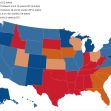At first glance, the US political divide seems to be firmly set in stone, with differing laws in place in states led by Republicans and Democrats; each to their own parties’ beliefs. But the messiness of wildly differing state mandates is confusing for internet and interstate businesses straddling the still-changing laws, and US citizens could face civil charges or large fines if they break, for example, state abortion laws or sex/gender mandates.
Beyond the obvious radical difference of opinion and philosophy of the Democrat and Republican parties, the question to ask now is: will these laws be overturned via a federal court case or the changes of state-led parties, after elections replace one party with another? How does it all work?
The laws covering states establishing new laws and the federal government overruling older laws are complex, but they do exist.
The Supreme Court and Preemptive Law
The U.S. Constitution declares that federal law is “the supreme law of the land.” Known as a preemption, this means that federal law will supersede state laws.
But states can be creative, as in the case of Roe v. Wade, and create new laws for their states. There is also wriggle room in the preemption clause that says if the federal law is “ambiguous,” the states can go against that law.
The United States Supreme Court’s ruling in Altria Group v. Good, 555 U.S. 70 (2008) says, “State laws that conflict with federal law are without effect.” The decision discussed the difference between express and implied preemption, and it identified ways to determine whether Congress intended federal law to preempt state law. The Court also cautioned that, when evaluating evidence of Congressional intent, courts should err on the side of state rather than federal authority.”
In cases of ambiguity in federal law, states may create laws differing from those federal laws.
Federal v. State abortion laws
Take abortion, for example, where changes in federal law opened the door to Republican-led states outlawing abortion, abortion prescription drugs, and even making it a crime to help someone seeking an abortion. When the U.S. Supreme Court overturned Roe v. Wade on June 24, 2022, the entire country went into a divided reaction of either dismay or joy, based upon the Republican platform that abortion of any type is murder versus the Democrat one that still believes abortion is a constitutional right.
Some states, expecting this decision, set up legal steps to protect abortion rights for women, including the process of how so-called “pro-choice” and “pro-life” states would battle over the women in each state, as well as those who assisted women seeking abortions in anti-abortion states, who could be prosecuted or sued. These “trigger laws” were created to go into effect if, and when, the Supreme Court overruled Roe v. Wade.
Now, about half of US states each have pro or anti-abortion laws on the books.
The hottest topic at issue now regarding abortion concerns prescription abortion drugs and their online availability. Numerous states are now passing laws that make anyone selling the abortion medication mifepristone subject to criminal prosecution. This new “crime” applies to both businesses that may advertise in an anti-abortion state or anyone smuggling in the abortion meds to a pregnant woman seeking an abortion in that state. This legal battlefield is raging, with a Texas judge trying to block nationwide access to the drug, which can be used to stop a pregnancy during the first ten weeks. Democrats, in their own lawsuit, are fighting to establish the medicine’s legality.
The effect of the High Court’s overturning of Roe v. Wade has been to throw the question back to the states, allowing state laws to make diametrically opposing decisions over the legality of abortion.
Just in 2022, about 364 bills plus executive orders by President Biden were introduced to protect abortion rights in 33 states. These bills and executive orders allow states to keep abortion legal, in spite of the newly overturned Roe v Wade.
In the US, it is possible for states to create laws that are not negated by federal laws, in some cases. In the case of abortion, after the US Supreme Court overturned Roe v. Wade, the legality of abortion was left to individual states.
States can also create laws to protect abortion rights without using Roe v. Wade at all. These legal abortion states can prohibit their state from interfering with a resident’s legal right to obtain an abortion, either before a certain number of weeks and/or to protect the health or life of a pregnant woman.
Currently, 17 states and the District of Columbia have created laws that protect the right to abortion. Of these 17 states, three protect the rights to abortion in their state constitutions; 12 explicitly allow abortions legally without any state interference; four plus DC codified their residents’ right to abortion without any state interference, and 11 have created laws protecting abortion providers and in some cases, citizens who assist patients from the reach of anti-abortion states and their opposing laws.
And what about Republican-led states? If the pendulum swings the other way in the future, say if a red state turns blue, what happens to its anti-abortion laws? Some anti-abortion states have already amended their constitutions to declare that it does not contain any protection for abortion rights or allow public funds to be used for abortion. Democrat-led states often have laws that protect anyone offering information, financial or other help to residents helping patients seeking abortions.
Although the outcome has been messy for the country as a whole, the effect of the overturning of Roe v. Wade is clear: states can decide for themselves whether to ban abortions or keep the right to a legal abortion safe in their particular state.
Of course, it is possible the issue could come back to the Supreme Court in a case seeking to overturn the Dobbs decision that overturned Roe v. Wade or strengthen it further, reestablishing abortion as a constitutional right or limiting what states can and can’t legislate in this politically sensitive area.






